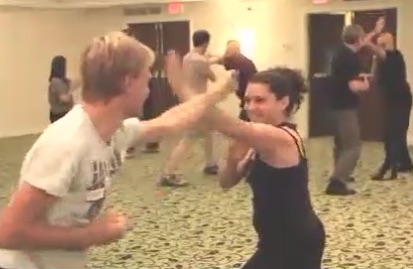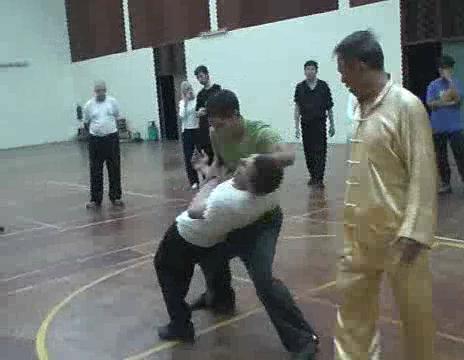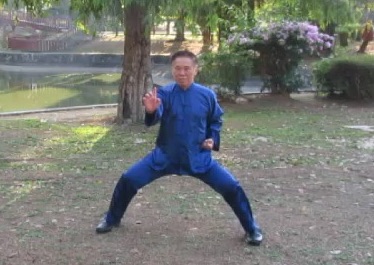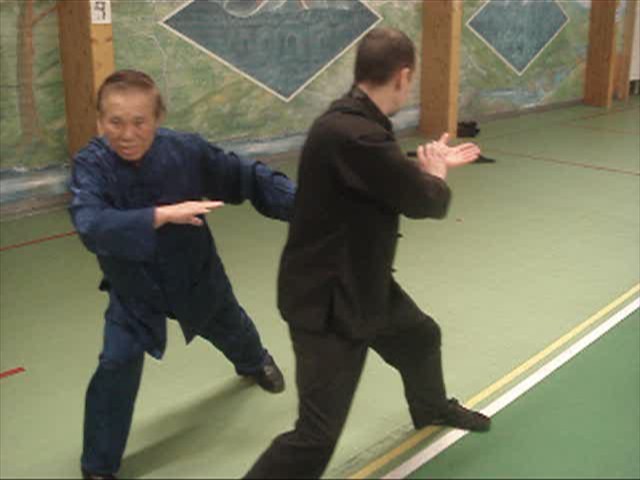SELECTION OF QUESTIONS AND ANSWERS
MARCH 2020 PART 3

Most Tai Chi practitioners have no internal force and cannot use their techniques for combat
Question 1
Hi, I have practiced various forms of Tai Chi & Chi Kung over the past few years. My aim is to be able to train to become an instructor, as I have been unable to find one myself. Please can you advise which course would be good to begin, are there any distance learning or video courses to use as a pre-requisite to any other courses? I'm a fair distance from any U.K. Instructors, but happy to travel for courses.
— Liz, England
Answer
I am sorry to say that much of Tai Chi Chuan, usually shortened to Tai Chi, and Chi Kung practiced today are just external forms without their essence. Most Tai Chi practitioners have no internal force and cannot use their techniques for combat. Many Chi Kung practitioners are sickly and weak despite having practiced Chi Kung for many years.
Our Tai Chi Chuan and Chi Kung instructors are trained from our students. They must be good students first. It is unlikely that you will be appointed as an instructor.
There are no distance learning or video courses for instructors. There are some Tai Chi Chuan videos for students as well as for non-Shaolin Wahnam students. Please see my webpage on "Overview of Taijiquan for Non-Shaolin Wahnam Members".
I would suggest that you learn from Sifu Tim or Sifu Barry of Fully Alive.
You can attend my Intensive Tai Chi Chuan Course and Intensive Chi Kung Course. Please check my website for available dates.
Question 2
Is it possible to live without doubt? Also, is it healthy to live without doubt?
— Warren, South Africa
Answer
Theoretically, it is possible to live without doubt. But in practice it never happens. So long as you are uncertain, you have doubt. For example, if you are uncertain whether the person you are talking to, will answer positively or negatively, you have doubt.
There are small doubts and big doubts, and the decision is usually subjective. In other words, you decide whether your doubts are big or small.
As it is in practice not possible to live without doubt, your question whether it is healthy to live without doubt, does not arise. But we can answer in theory. As doubt causes the mind to question, in my opinion, it is healthy to live without doubt.
On the other hand, much depends on the doubt itself. If a person is uncertain whether he will get well from his illness, it will be healthy when he thinks positively, i.e. he will get well. If he thinks negatively, he will aggravate his illness.

A sophisticated techniques
Question 3
What do you mean when you say that kungfu techniques are sophisticated?
— Paul, France
Answer
I mean that kungfu techniques are difficult to defend against or to counter when compared to techniques of other martial arts. For example, if you use a kungfu technique to fell an opponent, it would be more difficult for him to defend against or to counter it than if you had used other martial art techniques.
In my opinion, Shaolin Kungfu techniques are the most sophisticated. One important reason was that Shaolin Kungfu took 15 centuries to develop, whereas many martial arts today took less than a century. If you use certain Shaolin Kungfu techniques, there are no counters in the repertoire of many martial arts today.
Even when there is a counter, Shaolin Kungfu is more sophisticated. In a felling technique, for example, a Shaolin exponent needs to cover his opponent adequately so that the opponent cannot attack when the exponent executes the felling technique. This is not done in Judo, which is actually a sport. An opponent is not allowed to poke the eyes or grab the groin of the Judo exponent as Judo is protected by safety rules.
Question 4
I tried your kungfu techniques by learning from your videos, but each time I use them my sparring partner just bounces away.
Answer
In combat, skills are more important than techniques. You may use kungfu techniques but if your skills in applying these techniques are not as good as your opponent's skills in bouncing away, he will just bounce away.
This applies to any techniques. If you punch or kick your opponent, but your skills in punching or kicking are not as good as the skills of your opponent in defending or countering your attack, your attack will not be successful and you may be hit.
If we presume that the skills are the same, if you use a more sophisticated technique, your change of hitting your opponent will be more than if you had used a simple technique.
This applies to techniques where he knows the counters. For example, presuming that the skill level is the same, you may use a technique to punch your opponent who may defend and then counter-attack. If your technique is sophisticated, he will find it more difficult to counter-attack. If you use a simple technique, it will be easier for the opponent.
Skills need to be learnt from a competent teacher who is willing to teach you, not from a book or a video. For example, you don't learn how to drive or swim from books or videos but from living instructors. Even when you know the techniques of driving or swimming, unless you have the skills, you still cannot drive or swim.
I suggest that you attend my Intensive Shaolin Kungfu Course or my Intensive Taijiquan Course if you have some martial art foundation. Or you can attend my Intensive Chi Kung Course if you are new to chi kung and kungfu. You need to check my website for available dates.

One-Finger Shooting Zen
Question 5
The days have been great to me, or nights, rather, as I have been having a bout of night shifts working in the emergency department. I am very thankful to the Shaolin arts for giving me the energy and mental clarity needed to treat a wide variety of patients in a decisive manner. While I am still learning the subtleties of the art of medicine, it is undeniable that my kung fu training gives me an edge in virtually every situation here.
— Dr Frederick Chu, USA
Answer
Even if we leave aside combat efficiency, kungfu training gives us good health, vitality, longevity, peak performance and spiritual joy that surpass the wonderful benefits which chi kung training can give. Even when I am 75, I train kungfu everyday -- running, jumping and falling on the ground purposely without any injury.
Most kungfu practitioners unfortunately do not have combat efficiency, which is the basic aim of any kungfu. They just perform external kungfu forms, and use other martial art techniques if they have to spar or fight.
Fortunately they don't have to fight in our law-abiding society. They have good health, vitality and longevity, and often peak performance and spiritual joys though they may not relate these to their kungfu training. They are generally peaceful and happy.
But their benefits are nothing compared to ours. Ours is triple cultivation, whereas most practitioners practice kungfu at a physical level.
Here I am talking about genuine kungfu, which is very rare today. High-level genuine kungfu is rarer still. Those who add other martial art techniques in their sparring injure themselves generously.
Question 6
One Finger Shooting Zen has recently returned to becoming a daily practice. I remember you writing that sigung Ho recommended to practice it daily, even after one had become a master, and that its blend of the flow and force method makes it ideal for enhancing all other force training.
I am also very thankful for you sharing the importance of "shooting" out the consolidated internal force during training at the Becoming a Shaolin Wahnam Practitioner course in Malaysia.
Answer
I still practice One-Finger Shooting Zen everyday, as recommended by my sifu.
"Flowing force" and "consolidated force" were coined by me for our students' benefit. When my sifu, Sifu Ho Fatt Nam, taught me One-Finger Shooting Zen, he did not mention the two terms.
I discovered flowing force and consolidated force over many years of daily practice. I also discovered that first we must let our force flowing. Then we consolidate the force.

Grandmaster Wong applies a dim mark technique on Sifu Tim
Question 7
Is there a difference in the effect on the practitioner between "shooting" out flowing energy as opposed to consolidated energy? Is there a difference in the effect on the target being struck by flowing or consolidated energy derived from One Finger Shooting Zen?
Answer
I haven't consciously differentiate between hitting an opponent using flowing force or using consolidated force. I suppose there is a difference. But the difference is little because our force is great. Irrespective of whether we use flowing force or consolidated force, an opponent will be badly hurt if we use "hit force".
If we use "release force", an opponent may be pushed many feet away but he is not hurt. "Hit force" and "release force" are two main types of how we use our force. "Hit force" is to injure an opponent; "release force" is to send him many feet away without hurting him. Consolidated force is suitable for "hit force", whereas flowing force is suitable for "release force".
But it is relative. We can also use "flowing force", as in Taijiquan, as "hit force".
It is the same type of force, but it depends on how we use it. As an analogy, it is the same money, but it depends on how the money is used. For example, we may have money for rent, money for saving, money for food, and money for entertainment.
In the Iron Wire Set in Southern Shaolin, there are 12 types of force, which are hard force, soft force, pressing force, straight force, separate force, stabilizing force, inch force, lift force, retain force, circulate force, controlling force, and matching force.
In Taijiquan there are eight types of force, which are peng force, lu force, qi force, an force, cai force. lie force, zhou force and kao force, or force for warding of, rolling back, pressing forward, in contact, gripping, spreading, elbowing and anchoring.
Question 8
For those who wish to attain an advanced master's level in One Finger Shooting Zen, is there a certain amount of time per day to train the art? Are tools eventually introduced to the training, such as extinguishing candles or striking at a pole, mannequin, or poster with labelled vital points, or is that simply something passed on from movies and stories of training?
Answer
For those who wish to attain a master's level in One-Finger Shooting Zen, there is no fixed time to train. It depends much on the individuals. There is also a big difference between one who trains leisurely and another with much internal force. Generally if he can train for five times each side with internal force, it is quite sufficient.
Tools are eventually introduced to the training, such as extinguishing candles or striking at a pole, mannequin, or a poster with labelled vital points. These tools are actually practiced by masters, not just passed on from movies and stories.
Editorial Note: Dr Frederick Chu's questions will be continued at April 2020 Part 1 issue of the Questions-Answers Series.
LINKS
Selected Reading
- Happy Family Life Despite Different Needs and Aspirations
- Replacing White Crane Flaps Wings with Cloud Hands in Basic Taijiquan Syllabus
- History and Philosophy of Shaolin 72 Chin-Na Techniques
- One-Finger Shooting Zen -- the Treasure of Shaolin Wahnam
- Please Blow your Horn
